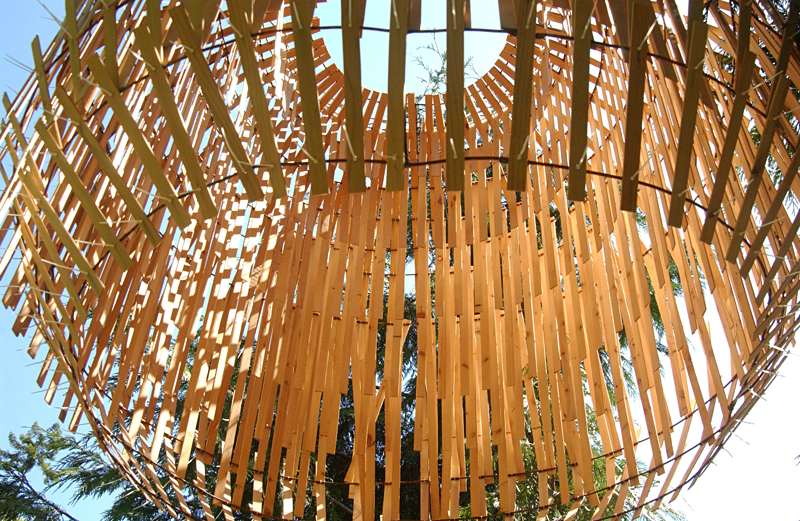I’m all in favor of anything that gets art outdoors, removed from trendy galleries and tidy museums, and of pushing urban artgoers away from the white wine, chitchat, and fashionable shoes that attend a typical opening. So is CoCA (the Center on Contemporary Art), whose “Heaven & Earth” again uses the overlooked, multi-trailed ravine of Carkeek Park to scatter nearly two dozen sculptural installations among the greenery. Curator David Francis supplied the conceit for 21 locals: “Cycles of Return,” appropriate given the restoration of Pipers Creek, where salmon again spawn in Carkeek. Water also figures in the show’s annex, at Point Shilshole Beach (a few miles south), where five more works are embedded in sea and sand.
“Heaven & Earth” is emphatically a walking tour, and its website includes a handy downloadable map to help locate each installation. Markers bearing those blobby Rorschach test–like QR codes also offer artist statements and descriptions—if your smartphone has the right software. Start with map in hand at the somewhat obscure Eddie McAbee park entrance (behind a shopping center off Holman Road Northwest; a small parking lot juts into Carkeek at Northwest 100th Place). From there, Pipers Creek Trail follows the watershed about 1.25 miles to Elliott Bay.
First on the itinerary, hanging from trees near the sidewalk, is a random cluster of sewn coffee bags and junk (or recycled items, if you prefer): Sentinel, a poor advertisement for what’s to follow. Does the art respond to the environment? That’s the question as you descend the gentle trail. In the remnants of the century-old Piper family orchard, restored during the ’80s, Chris Papa’s Graft (#3 on your map) appends a series of boxes onto an old stump. The resulting arch is a hybrid of the hewn and the natural, a reminder of how fruit trees themselves have been heavily engineered over millennia (long before gene-splicing or big agribusiness). The boxes look like beehives, also an essential and ancient agricultural technology.
Other pieces get lost in the woods, like a tree wrapped in twigs (#4), or are almost indistinguishable from trail-maintenance work. A walkway of split logs, #6, is pleasant to tread upon, not much to look at. Then there’s the problem that many pieces lie not on the ambling, shady path but closer to the parking lots and road (#5–#9). Yet a standout here is April Lelia’s twig-and-yarn Tree Cocoon (#7), dangling from a limb, which contains little human figurines in and out of the nest. It’s intended to decay in place, echoing the natal/fatal cycle of the salmon nearby.
Perhaps the best piece in the show is Brian Gerich’s Consistency (#8), a large cedar orb suspended in a grove of cedar trees. It’s like an oversized Noguchi lamp lit by the sun. The slats, held together by zip ties, cast fascinating shadows on the ground, where you’ll be tempted to lie down and stare up through the thing. The pendant sphere smells good, too. [SEPT. 2 UPDATE: This piece has reportedly been removed and destroyed by park workers, unaware of its origin.]
Down the trail near the railroad tracks is the sole conceptual work, Airing Our Laundry (#10), with supersized bloomers and other garments sewn from big-blue-tarp material and other unnatural fabrics. Looping up to the main parking lot and viewpoint (where the pedestrian bridge spans the dangerous tracks), two dismal and obvious sculptural assemblages enjoy the best siting. The whimsical scrap-metal giant Organica/Mechanica (#13) almost spoils the view of the Olympics and Sound. You’ve got to loop back up the hill (another half-mile) to reach three unremarkable pieces at the visitors’ center. Returning to your car via Pipers Creek is a little over two miles.
Now, what and where is Point Shilshole Beach? Opposite Paseo Caribbean Restaurant, tucked between a condo and the Shilshole Bay Beach Club, is a gated private beach, owned by the condo but open to the public. There I find moms and kids playing in the sand while paddleboarders and swimmers splash out to the rotting pilings offshore, where a new beaded curtain dangles into the water. Designed by David Francis, Marine Curtain (marked “E”) sways and rearranges itself with the tide—you can swim out to get a closer look. But where are works A–D? CoCA says some are sand sculptures that get washed away and are rebuilt every Monday; another is only revealed at low tide (think back to “Cycles of Return”).
But beyond the trail shoes, sunscreen, and Google maps, maybe bringing a swimsuit, fins, and mask would make “Heaven & Earth” that much more immersive and satisfying. Even if not every piece impresses, simply finding them makes for an aesthetic adventure. Here’s an art walk where those two terms carry equal weight. For next year’s edition, perhaps the theme should be “Let’s Get Lost,” with GPS waypoints instead of QR codes, less pavement and more dirt.








